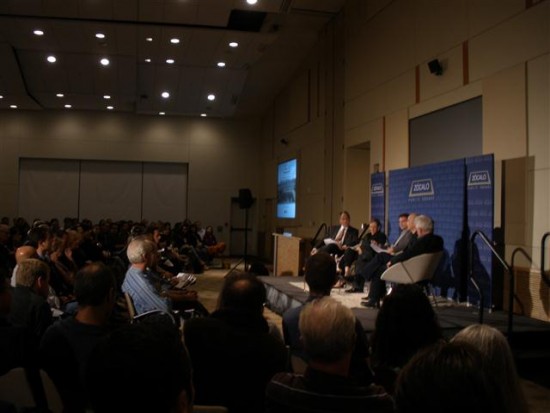 I attended my first Zocalo Public Square event this evening, hopping on the 94 Metro Local bus from Glendale, getting off at Ord Street in Chinatown and riding down a few blocks to The California Endowment‘s facility on Alameda.
I attended my first Zocalo Public Square event this evening, hopping on the 94 Metro Local bus from Glendale, getting off at Ord Street in Chinatown and riding down a few blocks to The California Endowment‘s facility on Alameda.
Zocalo, named after Mexico City’s famous central plaza, is an ongoing public salon/panel dealing with modern-day topics concerning life in modern Los Angeles. It’s usually attended by intelligent, educated folk (which is why I’m there – j/k), scholars, students, community folk, concerned citizens or the intellectually curious.
Tonight’s topic, entitled, “How To Imagine A More Integrated L.A.,” dealt with a concept devised by a group of architects to (hopefully) transform a potentially-obsolete Union Pacific Railroad intermodal facility across the L.A. River from Union Station (known as LATC for the rail folks) into a large open space, bordered by a pedestrian- and transit-friendly mixed-use district.The purpose was to design this land in such a way as to transform not only the physical environment, but the human environment as well.

Currently, it’s a place where domestic truck trailers and containers are loaded to and off-loaded from railcars. The architects speculate that within the next 20 years the railroad may move its facility elsewhere and sell the large swath of land – the largest plot of land in Downtown L.A. owned by a single private entity.
The four panelists, Marc Salette, Jim Stafford, Mia Lehrer and Michael Maltzan – all of them architects by trade – shared their vision, expectations and concerns about the project.
I arrived at the nearly-packed event in the nick of time and didn’t know what to expect, but ended up running into several friends from various circles there. There were some very astute questions from the audience, which ranged from cultural and economic diversity to integration with the larger L.A. River vision to the real-life possibility of this all happening.
Honestly, there’s no guarantee that the railroad, if it even decides to sell the land at all, would sell to the appropriate public-private entities that would make this happen. Knowing how the railroads operate, it largely deals with economics, especially domestic, continental and international trade. Railroads in the Los Angeles area have abandoned facilities (Taylor Yard, Cornfields Yard) for public use, though the obsolesence of those facilities were more related to corporate mergers and technological infrastructure. Being that the piggyback facility deals primarily with domestic freight, they may still very well be a need to retain the usage of this yard in 20 years. But assuming they do sell it, I obviously think it’s an awesome concept with lots of possibilities for Downtown and the rest of Los Angeles.
After the Zocalo event was an outdoor reception in the courtyard. I got to chat with former 13th District L.A. City Councilman Michael Woo, who was the moderator for the event. I hadn’t seen him in some nine years, and now he is the dean of the Environmental Design school at Cal Poly University, Pomona. He had recently joined Facebook and for some reason I became his very first FB friend(!)
A summary of the event, including photos and video, can be seen on this page:
http://zocalopublicsquare.org/thepublicsquare/2010/09/22/how-to-imagine-a-more-integrated-l-a/
Leave a Reply